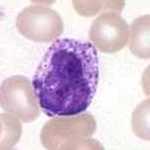Basophil facts for kids
Quick facts for kids Basophil granulocyte |
|
|---|---|
 |
|
| Basophil granulocyte | |
 |
|
| Basophil | |
| Code | TH H2.00.04.1.02022 |
Basophils are special types of white blood cells. They are also called basophil granulocytes. These cells are quite rare in your body. For example, if you had 10,000 white blood cells, only about 1 to 30 of them would be basophils.
Basophils have large particles inside them called granules. These granules are so big that they can hide the cell's center, called the cell nucleus, when stained. If the cell isn't stained, you can see the nucleus. It usually looks like it has two parts, or "lobes."
Contents
What Do Basophils Do?
Basophils are part of your body's amazing defense system. This system is known as the immune system. They help protect you from tiny invaders. They also play a role in allergic reactions.
Basophils and Mast Cells: What's the Difference?
There's another type of cell called a mast cell. It looks and acts a lot like a basophil. Both basophils and mast cells store a chemical called histamine. When these cells are activated, they release histamine. This chemical is important for your body's response to injuries or invaders.
Even though they are similar, basophils and mast cells come from different cell lines. Mast cells usually stay in your body's tissues, like connective tissue. They do not travel much in the blood. Basophils, on the other hand, travel in your blood. When your body needs them, they can move from the blood into different tissues.
Why Are They Called Basophils?
The name "basophil" comes from how these cells react to special dyes. Scientists use these dyes in labs. "Basophilic" means they are "base-loving." This means they get stained easily by basic dyes. This helps scientists see them clearly under a microscope. The pictures in this article show how they look when stained.
How Basophils Protect Your Body
Scientists are still learning exactly how basophils work. We know that basophils have special proteins on their surface. These proteins can grab onto a type of antibody called IgE. Antibodies are like tiny flags. They help your immune system recognize threats.
IgE is involved in fighting off larger parasites. It is also involved in allergic reactions. Basophils are often found in large numbers where there are infections. This includes infections from tiny creatures like ticks. This suggests they are important for defending your body against these kinds of invaders.
Images for kids
See also
 In Spanish: Basófilo para niños
In Spanish: Basófilo para niños



